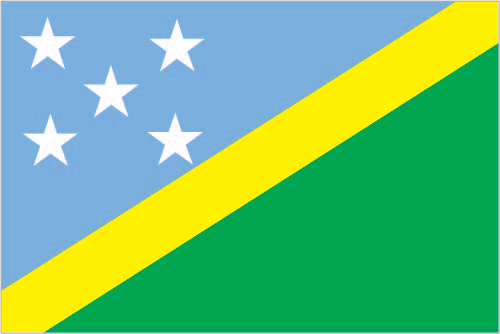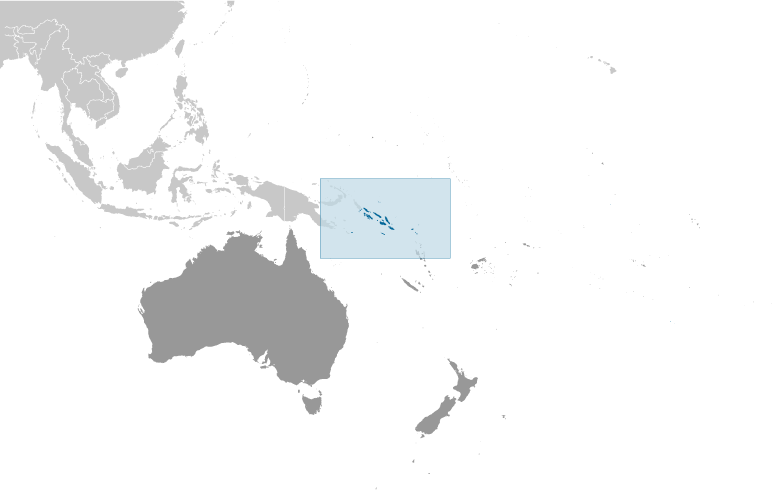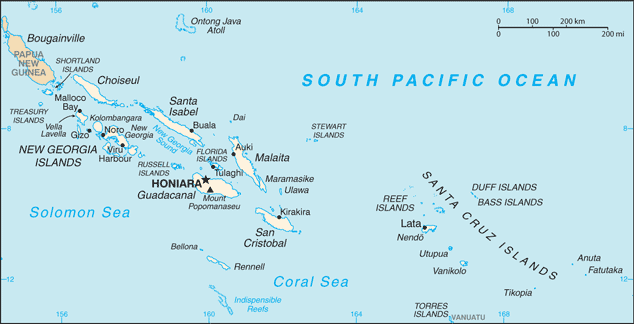



Australia-Oceania :: SOLOMON ISLANDS
- Hide
Introduction :: SOLOMON ISLANDS
Panel - Expanded -
The UK established a protectorate over the Solomon Islands in the 1890s. Some of the bitterest fighting of World War II occurred on this archipelago. Self-government was achieved in 1976 and independence two years later. Ethnic violence, government malfeasance, endemic crime, and a narrow economic base have undermined stability and civil society. In June 2003, then Prime Minister Sir Allan KEMAKEZA sought the assistance of Australia in reestablishing law and order; the following month, an Australian-led multinational force arrived to restore peace and disarm ethnic militias. The Regional Assistance Mission to the Solomon Islands (RAMSI) has generally been effective in restoring law and order and rebuilding government institutions.
- Hide
Geography :: SOLOMON ISLANDS
Panel - Expanded -
Oceania, group of islands in the South Pacific Ocean, east of Papua New Guinea8 00 S, 159 00 EOceaniatotal: 28,896 sq kmland: 27,986 sq kmwater: 910 sq kmcountry comparison to the world: 144slightly smaller than Maryland0 km5,313 kmmeasured from claimed archipelagic baselinesterritorial sea: 12 nmexclusive economic zone: 200 nmcontinental shelf: 200 nmtropical monsoon; few temperature and weather extremesmostly rugged mountains with some low coral atollslowest point: Pacific Ocean 0 mhighest point: Mount Popomanaseu 2,310 mfish, forests, gold, bauxite, phosphates, lead, zinc, nickelagricultural land: 3.9%arable land 0.7%; permanent crops 2.9%; permanent pasture 0.3%forest: 78.9%other: 17.2% (2011 est.)NA44.7 cu km (2011)typhoons, but rarely destructive; geologically active region with frequent earthquakes, tremors, and volcanic activity; tsunamisvolcanism: Tinakula (elev. 851 m) has frequent eruption activity, while an eruption of Savo (elev. 485 m) could affect the capital Honiara on nearby Guadalcanaldeforestation; soil erosion; many of the surrounding coral reefs are dead or dyingparty to: Biodiversity, Climate Change, Climate Change-Kyoto Protocol, Desertification, Environmental Modification, Law of the Sea, Marine Dumping, Marine Life Conservation, Ozone Layer Protection, Whalingsigned, but not ratified: none of the selected agreementsstrategic location on sea routes between the South Pacific Ocean, the Solomon Sea, and the Coral Sea; on 2 April 2007 an undersea earthquake measuring 8.1 on the Richter scale occurred 345 km WNW of the capital Honiara; the resulting tsunami devastated coastal areas of Western and Choiseul provinces with dozens of deaths and thousands dislocated; the provincial capital of Gizo was especially hard hit
- Hide
People and Society :: SOLOMON ISLANDS
Panel - Expanded -
noun: Solomon Islander(s)adjective: Solomon IslanderMelanesian 95.3%, Polynesian 3.1%, Micronesian 1.2%, other 0.3% (2009 est.)Melanesian pidgin (in much of the country is lingua franca), English (official but spoken by only 1%-2% of the population), 120 indigenous languagesProtestant 73.4% (Church of Melanesia 31.9%, South Sea Evangelical 17.1%, Seventh Day Adventist 11.7%, United Church 10.1%, Christian Fellowship Church 2.5%), Roman Catholic 19.6%, other Christian 2.9%, other 4%, none 0.03%, unspecified 0.1% (2009 est.)622,469 (July 2015 est.)country comparison to the world: 1690-14 years: 35.68% (male 114,349/female 107,750)15-24 years: 20.01% (male 64,036/female 60,512)25-54 years: 35.73% (male 113,306/female 109,133)55-64 years: 4.45% (male 13,863/female 13,820)65 years and over: 4.13% (male 12,315/female 13,385) (2015 est.)total dependency ratio: 75.1%youth dependency ratio: 69.1%elderly dependency ratio: 5.9%potential support ratio: 16.8% (2015 est.)total: 21.6 yearsmale: 21.4 yearsfemale: 21.8 years (2014 est.)2.02% (2015 est.)country comparison to the world: 4825.77 births/1,000 population (2015 est.)country comparison to the world: 483.85 deaths/1,000 population (2015 est.)country comparison to the world: 210-1.75 migrant(s)/1,000 population (2015 est.)country comparison to the world: 162urban population: 22.3% of total population (2015)rate of urbanization: 4.25% annual rate of change (2010-15 est.)HONIARA (capital) 73,000 (2014)at birth: 1.05 male(s)/female0-14 years: 1.06 male(s)/female15-24 years: 1.06 male(s)/female25-54 years: 1.04 male(s)/female55-64 years: 1 male(s)/female65 years and over: 0.92 male(s)/femaletotal population: 1.04 male(s)/female (2015 est.)total: 15.65 deaths/1,000 live birthsmale: 17.84 deaths/1,000 live birthsfemale: 13.35 deaths/1,000 live births (2015 est.)country comparison to the world: 102total population: 75.12 yearsmale: 72.49 yearsfemale: 77.88 years (2015 est.)country comparison to the world: 1063.28 children born/woman (2015 est.)country comparison to the world: 4934.6% (2006/07)5.1% of GDP (2013)country comparison to the world: 590.22 physicians/1,000 population (2009)1.3 beds/1,000 population (2012)improved:urban: 93.2% of populationrural: 77.2% of populationtotal: 80.8% of populationunimproved:urban: 6.8% of populationrural: 22.8% of populationtotal: 19.2% of population (2015 est.)improved:urban: 81.4% of populationrural: 15% of populationtotal: 29.8% of populationunimproved:urban: 18.6% of populationrural: 85% of populationtotal: 70.2% of population (2015 est.)NANANA25% (2014)country comparison to the world: 2711.5% (2007)country comparison to the world: 659.9% of GDP (2010)country comparison to the world: 18definition: age 15 and over can read and writetotal population: 84.1%male: 88.9%female: 79.2% (2009 est.)total: 9 yearsmale: 10 yearsfemale: 9 years (2007)
- Hide
Government :: SOLOMON ISLANDS
Panel - Expanded -
conventional long form: noneconventional short form: Solomon Islandslocal long form: nonelocal short form: Solomon Islandsformer: British Solomon Islandsparliamentary democracy and a Commonwealth realmname: Honiarageographic coordinates: 9 26 S, 159 57 Etime difference: UTC+11 (16 hours ahead of Washington, DC, during Standard Time)9 provinces and 1 city*; Central, Choiseul, Guadalcanal, Honiara*, Isabel, Makira and Ulawa, Malaita, Rennell and Bellona, Temotu, Western7 July 1978 (from the UK)Independence Day, 7 July (1978)adopted 31 May 1978, effective 7 July 1978; amended several times, last in 2010 (2012)mixed legal system of English common law and customary lawhas not submitted an ICJ jurisdiction declaration; non-party state to the ICCt21 years of age; universalchief of state: Queen ELIZABETH II (since 6 February 1952); represented by Governor General Frank KABUI (since 7 July 2009)head of government: Prime Minister Manasseh SOGAVARE (since 9 December 2014)cabinet: Cabinet appointed by the governor general on the advice of the prime ministerelections/appointments: the monarchy is hereditary; governor general appointed by the monarch on the advice of the National Parliament for up to 5 years (eligible for a second term); following legislative elections, the leader of the majority party or majority coalition usually elected prime minister by the National Parliament; deputy prime minister appointed by the governor general on the advice of the prime minister from among members of the National Parliamentelection results: Manasseh SOGAVARE (independent) elected prime minister; National Parliament vote - 31 to 19description: unicameral National Parliament (50 seats; members directly elected in single-seat constituencies by simple majority vote to serve 4-year terms)elections: last held on 19 November 2014 (next to be held in 2018)election results: percent of vote by party - NA; seats by party - independents 32, DAP 7, UDP 5, PAP 3, KPSI 1, SIPFP 1, SIPRA 1highest court(s): Court of Appeal (consists of the court president, and ex officio members to include the High Court chief justice and its puisne judges); High Court (consists of the chief justice and puisne judges as prescribed by the National Parliament)judge selection and term of office: Court of Appeal and High Court president, chief justices, and puisne judges appointed by the governor-general upon recommendation of the Judicial and Legal Service Commission, chaired by the chief justice to include 5 members, mostly judicial officials and legal professionals; all judges appointed until retirement at age 60subordinate courts: Magistrates' Courts; local courts; Customary Land Appeal CourtDemocratic Alliance Party or DAP [Steve ABANA]Kadere Party of Solomon Islands or KPSI [Alfred LEGUA]People's Alliance Party or PAP [Nathaniel WAENA]Solomon Islands People First Party or SIPFP [Jimmie RODGERS]Solomon Islands Party for Rural Advancement or SIPRA [Manasseh MAELANGA]United Democratic Party [Thomas Ko CHAN]note: in general, Solomon Islands politics is characterized by fluid coalitionsIsatabu Freedom Movement or IFMMalaita Eagle Force or MEFnote: these rival armed ethnic factions crippled the Solomon Islands in a wave of violence from 1999 to 2003ACP, ADB, AOSIS, C, EITI (candidate country), ESCAP, FAO, G-77, IBRD, ICAO, ICRM, IDA, IFAD, IFC, IFRCS, ILO, IMF, IMO, IOC, ITU, MIGA, OPCW, PIF, Sparteca, SPC, UN, UNCTAD, UNESCO, UPU, WFTU, WHO, WMO, WTOchief of mission: Ambassador Collin David BECK (since 31 March 2004)chancery: 800 Second Avenue, Suite 400L, New York, NY 10017telephone: [1] (212) 599-6192, 6193FAX: [1] (212) 661-8925the US does not have an embassy in the Solomon Islands; the US ambassador to Papua New Guinea is accredited to the Solomon Islandsdivided diagonally by a thin yellow stripe from the lower hoist-side corner; the upper triangle (hoist side) is blue with five white five-pointed stars arranged in an X pattern; the lower triangle is green; blue represents the ocean; green the land; and yellow sunshine; the five stars stand for the five main island groups of the Solomon Islandsnational colors: blue, yellow, green, whitename: "God Save Our Solomon Islands"lyrics/music: Panapasa BALEKANA and Matila BALEKANA/Panapasa BALEKANAnote: adopted 1978
- Hide
Economy :: SOLOMON ISLANDS
Panel - Expanded -
The bulk of the population depends on agriculture, fishing, and forestry for at least part of its livelihood. Most manufactured goods and petroleum products must be imported. The islands are rich in undeveloped mineral resources such as lead, zinc, nickel, and gold. Prior to the arrival of The Regional Assistance Mission to the Solomon Islands (RAMSI), severe ethnic violence, the closing of key businesses, and an empty government treasury culminated in economic collapse. RAMSI's efforts to restore law and order and economic stability have led to modest growth as the economy rebuilds.$1.09 billion (2014 est.)$1.074 billion (2013 est.)$1.042 billion (2012 est.)note: data are in 2014 US dollarscountry comparison to the world: 203$1.155 billion (2014 est.)1.5% (2014 est.)3% (2013 est.)4.7% (2012 est.)country comparison to the world: 199$1,900 (2014 est.)$1,900 (2013 est.)$1,800 (2012 est.)note: data are in 2014 US dollarscountry comparison to the world: 2064.2% of GDP (2014 est.)10.8% of GDP (2013 est.)18.2% of GDP (2012 est.)country comparison to the world: 166agriculture: 51.9%industry: 10%services: 38.1% (2014 est.)cocoa, coconuts, palm kernels, rice, fruit; cattle, pigs; fish; timberfish (tuna), mining, timber-0.4% (2014 est.)country comparison to the world: 174202,500 (2007 est.)country comparison to the world: 170agriculture: 75%industry: 5%services: 20% (2000 est.)NA%NA%lowest 10%: NA%highest 10%: NA%revenues: $450.3 millionexpenditures: $450.3 million (2014 est.)38.8% of GDP (2014 est.)country comparison to the world: 430% of GDP (2014 est.)country comparison to the world: 37calendar year5.1% (2014 est.) 6.7% (2013 est.)country comparison to the world: 17210.9% (31 December 2014 est.)10.77% (31 December 2013 est.)country comparison to the world: 74$404.9 million (31 December 2014 est.)$366.7 million (31 December 2013 est.)country comparison to the world: 168$452.1 million (31 December 2014 est.)$467.9 million (31 December 2013 est.)country comparison to the world: 182$27.51 million (31 December 2014 est.)$24.46 million (31 December 2013 est.)country comparison to the world: 181-$98 million (2014 est.)-$1.2 million (2012 est.)country comparison to the world: 62$493.1 million (2012 est.)$439.8 million (2011 est.)country comparison to the world: 175timber, fish, copra, palm oil, cocoaChina 55.5%, Australia 13.6%, Italy 4.3% (2013)$446 million (2012 est.)$462.8 million (2012 est.)country comparison to the world: 192food, plant and equipment, manufactured goods, fuels, chemicalsAustralia 27.2%, Singapore 24.1%, China 7%, Malaysia 4.2%, NZ 4.2% (2013)$255.5 million (31 December 2011 est.)$228.1 million (31 December 2012 est.)country comparison to the world: 185$1.088 billion (31 December 2014 est.)$1.01 billion (31 December 2013 est.)country comparison to the world: 104$35.8 million (31 December 2014 est.)$35.8 million (31 December 2013 est.)country comparison to the world: 96Solomon Islands dollars (SBD) per US dollar -7.329 (2014 est.)7.3021 (2013 est.)7.36 (2012 est.)7.6413 (2011 est.)8.0645 (2010 est.)
- Hide
Energy :: SOLOMON ISLANDS
Panel - Expanded -
85 million kWh (2011 est.)country comparison to the world: 20379.05 million kWh (2011 est.)country comparison to the world: 2020 kWh (2013 est.)country comparison to the world: 1130 kWh (2013 est.)country comparison to the world: 12436,000 kW (2011 est.)country comparison to the world: 197100% of total installed capacity (2011 est.)country comparison to the world: 80% of total installed capacity (2011 est.)country comparison to the world: 560% of total installed capacity (2011 est.)country comparison to the world: 1610% of total installed capacity (2011 est.)country comparison to the world: 1620 bbl/day (2013 est.)country comparison to the world: 1580 bbl/day (2010 est.)country comparison to the world: 880 bbl/day (2010 est.)country comparison to the world: 1640 bbl (1 January 2014 est.)country comparison to the world: 1110 bbl/day (2010 est.)country comparison to the world: 1251,870 bbl/day (2013 est.)country comparison to the world: 1930 bbl/day (2010 est.)country comparison to the world: 1571,463 bbl/day (2010 est.)country comparison to the world: 1870 cu m (2012 est.)country comparison to the world: 1090 cu m (2012 est.)country comparison to the world: 1230 cu m (2012 est.)country comparison to the world: 670 cu m (2012 est.)country comparison to the world: 1650 cu m (1 January 2014 est.)country comparison to the world: 116266,000 Mt (2012 est.)country comparison to the world: 194
- Hide
Communications :: SOLOMON ISLANDS
Panel - Expanded -
total subscriptions: 7,500subscriptions per 100 inhabitants: 1 (2014 est.)country comparison to the world: 201total: 376,700subscriptions per 100 inhabitants: 62 (2014 est.)country comparison to the world: 174domestic: mobile-cellular telephone density is about 50 per 100 personsinternational: country code - 677; satellite earth station - 1 Intelsat (Pacific Ocean) (2011)Solomon Islands Broadcasting Corporation (SIBC) is the sole TV broadcaster with 1 station; multi-channel pay-TV is available; SIBC operates 2 national radio stations and 2 provincial stations; 2 local commercial radio stations; Radio Australia is available via satellite feed (2009)AM 1, FM 1, shortwave 1 (2004).sbtotal: 46,400percent of population: 7.6% (2014 est.)country comparison to the world: 187
- Hide
Transportation :: SOLOMON ISLANDS
Panel - Expanded -
36 (2013)country comparison to the world: 109total: 11,524 to 2,437 m: 1 (2013)total: 351,524 to 2,437 m: 1914 to 1,523 m: 10under 914 m:24 (2013)3 (2013)total: 1,390 kmpaved: 34 kmunpaved: 1,356 kmnote: includes 920 km of private plantation roads (2011)country comparison to the world: 179major seaport(s): Honiara, Malloco Bay, Viru Harbor, Tulaghi
- Hide
Military :: SOLOMON ISLANDS
Panel - Expanded -
no regular military forces; Royal Solomon Islands Police Force (2013)males age 16-49: 142,913 (2010 est.)males age 16-49: 118,921females age 16-49: 118,164 (2010 est.)male: 6,483female: 6,098 (2010 est.)
- Hide
Transnational Issues :: SOLOMON ISLANDS
Panel - Expanded -
since 2003, the Regional Assistance Mission to Solomon Islands, consisting of police, military, and civilian advisors drawn from 15 countries, has assisted in reestablishing and maintaining civil and political order while reinforcing regional stability and securitycurrent situation: The Solomon Islands is a source and destination country for local adults and children and Southeast Asian men and women subjected to forced labor and forced prostitution; women from China, Indonesia, Malaysia, and the Philippines are recruited for legitimate work and upon arrival are forced into prostitution; men from Indonesia and Malaysia recruited to work in the Solomon Islands’ mining and logging industries may be subjected to forced labor; local children are forced into prostitution near foreign logging camps, on fishing vessels, and at hotel and other entertainment venues; some local children are also sold by their parents for marriage to foreign workers or put up for “informal adoption†and then find themselves forced into domestic servitude or forced prostitutiontier rating: Tier 2 Watch List – The Solomon Islands does not fully comply with the minimum standards for the elimination of trafficking; however, it is making significant efforts to do so; in 2013, the government passed but did not gazette implementing regulations for 2012 legislation prohibiting all forms of human trafficking; authorities investigated an unspecified number of labor trafficking cases in the fishing industry but did not prosecute or convict any suspected offenders or actively assist victims; the government did not allocate funding for national anti-trafficking efforts in 2013; the country lacks systematic procedures for identifying trafficking victims among high-risk groups and a formal mechanism for referring victims to care; civil society and religious organizations provide limited services to victims; no anti-trafficking awareness-raising campaigns were conducted in 2013 (2014)
